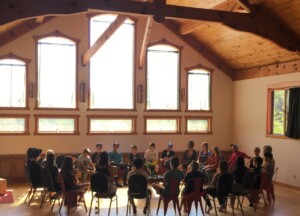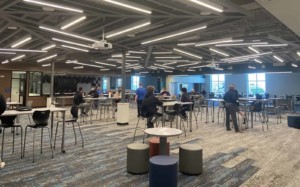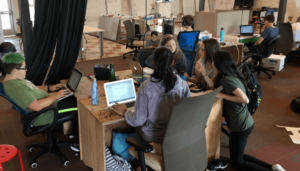What’s The Next Big Idea? Microschool Networks

Have a good learning idea? Try it with six kids tomorrow, plan an after-school event for next week or advertise a week long summer school opportunity. If that works, launch a small school for 15 students in the fall.
Microschools have been popping up around the country for the last decade. New learning tools and strategies have made the opportunity to open “microschools” as a school-within-a-school or as a low-cost private school a lot easier. Microschools serve 15 to 150 students and, as illustrated by CottageClass in Brooklyn, may be full or part-time learning experiences for P-12 students.
The question now becomes how to make it easier to launch schools and enroll students. Enter microschool networks–loose and tight affiliations of teacher-led schools that provide platforms, instructional materials, professional learning, enrollment and back office support.
Matt Candler is founder of 4.0 Schools, a national community of people testing new designs in schools, and sees new interest in microschools all over the country. “We’re see growing interest in microschools from people you might expect, entrepreneurial educators eager to try a new approach to learning at a small, humanizing scale. But we’re also seeing interest from unusual suspects like superintendents curious about the power of microschooling within a district. That’s really exciting. We’re adapting our pop-up and field trial investment programs so anyone can learn to create smaller, more modular learning spaces that work for all kids.”
Microschools created the space for teachers and school leaders to rethink school on a small scale. As with anything, however, working in isolation can be draining and inefficient. Microschool networks have the ability to create powerful learning while leaning on the network effect to scale and increase impact.
We think networks are the most important innovations in the modern era of U.S. K-12 education. Not only do they boost graduation rates and achievement, but they expand high-quality options to communities that need them most. Being part of a network provides:
- The ability to take risks, design and innovate new ideas with support and experience of others;
- Curated curriculum materials and technology tools;
- Common design principles that are core to the network model (helps with reflection, implementation and improvement);
- Professional learning and networking opportunities;
- More data to make better-informed decisions — the ability to learn from others within network, either with similar successes, trials and/or challenges
Leveraging The Power Of Place
To equip learners with deeper learning outcomes, microschools have the agility to connect with community and leverage the “power of place.” Through authentic community-connected experiences, students learn to collaborate, think critically and solve complex challenges. Learners become invested in their communities and ready for further education and entrepreneurship.
Place-based education (PBE) takes advantage of geography to make learning authentic, meaningful and engaging for learners. Place-based microschool networks like Teton Science Schools provide immersive learning experience that places students in local heritage, cultures, landscapes, opportunities and experiences–using these as a foundation for the study of language arts, mathematics, social studies, science and other subjects across the curriculum (for more, check out our #PlaceBasedEd campaign).
A Really Big Idea That Starts Really Small
Building urban, rural and thematic microschool networks support powerful learning for all by creating a variety of options for students to find the place where they learn best.
Urban Microschool Network
Innovative urban school districts, like Denver Public Schools, are contemplating networks of microschools. Dozens of new small schools could pilot new innovations and create a web of learning opportunities. The microschools could serve three ends:
- Expanding family options by providing a rich web of teacher-led schools;
- Piloting new learning innovations that grow into larger schools; and
- Demonstrating innovations that are absorbed by a host school.
Networks of Rural Microschools
Shrinking rural populations and the school consolidation craze that started in the 70s led to the closure of thousands of rural schools. Closing a high school, often the heart and soul of a community can be the death knell for a rural community. Networks of rural microschools will allow small towns and rural communities to reopen schools.
Rural microschools could be operated by school districts in a “hub and spoke” model where student spend a day or two a week in a central facility. They could also operate (where multicampus charters are allowed) as managed network with common back office services.
Thematic Networks of Microschools
In addition to regional networks, thematic networks could connect schools around specific assets including:
- Student-centered learning (Acton Academy)
- Personalized learning (Altschool)
- Museums (Houston A+ UP)
- Science schools at zoos (Tacoma SAMI)
- Intentionally diverse cross-city learning spaces (NOLA Micro Schools)
- Civics-focused schools in state capitols and city hall (Chavez Schools)
- Logistics focused schools in distribution centers
- AgTech schools in Deere or Caterpillar dealers
- Schools in advanced manufacturing facilities (GPS Education)
- Symphony, opera and theater schools
- Health science schools at hospitals
- Service-oriented schools in churches and service organizations
- Environmental science schools in national parks
You get the idea. Any assets associated with job clusters could be a home for (or partner with) a microschool.
How Will Microschool Networks Be Organized?
There will be several kinds of microschool networks, some with loose affiliations and tightly managed networks (see options below). Platform networks–leveraging tools from Altschool, Summit Learning, New Tech Network and InnovateEdu— are likely to be most common.

Where charter laws allow multi-campus schools, managed networks will be common.
There will be a variety of thematic networks, some will leverage a common learning model and platform (like GPS) while others will be loose affiliates of like-minded schools.
We think these little schools are a big idea.
To learn more about microschools
- Listen: Getting Smart Podcast: Matt Candler on the #FutureOfSchool
- Read: Microschools with Macro Impact
- Watch: Student-Centered Learning Design Focused Learning at One Stone
- Design: 4.0 Schools and Getting Smart Services
- Teacher-leadership: Teacher-Powered Schools
Stay in-the-know with all things EdTech and innovations in learning by signing up to receive the weekly Smart Update. This post includes mentions of a Getting Smart partner. For a full list of partners, affiliate organizations and all other disclosures please see our Partner page.






Meredith G
Micro-schools could address multiple issues of close relationships, flexible teaching models, and local ties in many ways, while also having the stability and resources of the network. I think micro-school networks could really benefit community and family engagement.
In our online, distracted, fast moving culture I have really seen a decline in community interaction from the district level all the way down to simple neighbor interactions. A lot of times I feel like teachers receive more pressure but less communication and cooperation than ever. I feel that families don't have that community relationship with peers, are residents, or faculty that I remember. Giant schools are also definitely not the answer, and I hate the distances many kids have to commute to school.
And while I definitely see the benefits of possible micro-school networks, and I would say I am very much behind the idea and moving forward, my enthusiasm is still tempered somewhat by a few things.
For all of us it is easy to forget that while large class sizes are not great, the outcomes of small classes can depend on the quality of the teacher and instruction than the number. Studies looking at class size effect research has shown inconsistent results across large samples.
Teacher directed and led sounds great, but I have also seen how wrong that can go. I would be willing to bet anyone with an incompetent or overzealous or optimistic coworker could imagine. Personally I worked at a non-profit montessori preschool that was one of three locations founded and run by a montessori teacher and a business woman. I had the misfortune of being at the location that was overseen day to day by the former teacher. Her stress from inexperience and inability in operations caused problems for the staff and the children. When upset at her failings she would enter the classroom and jump in trying to make changes, obviously to regain some sense of control and purpose. In reality, her direction often contradicted and undermined the lead teacher with no need given or in benefit to anyone. Maybe these networks would be set up better, but I know for me personally operations responsibilities could take away from the joy of teaching.
The other issue is the right fit, and different needs in communities and families. I worry that the need for great, local options will seem taken care of by these micro schools, but what about the children or families that possibly don’t click. With different methodologies and leadership, there is a chance that schools that focus on technology or science and nature, or whatever it may be may not work best for some children and having their children in multiple schools can be a strain on parents. I know parents that have their children in three different private schools, but a single parent in a rural community may not have that option. In a large county there may be a school that perfectly fits your child's needs but if its a great distance away, for your child it has not solved the issue of commute, or community schooling.
Affordable, innovative micro schools such as AltSchool or Acton Academy have had lots of buzz, and high satisfaction from parents, some who have moved their children across the country to attend. The schools have not become prevalent enough to truly shake up the system but I always advise caution in what effects such a switch could have on public schools, affordable options, communities, and of course teachers and students.